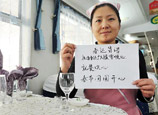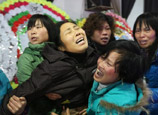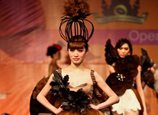
It's a luxurious hobby, not something just anybody can afford. "I guess I have spent about 500,000 yuan in jeans in all," said Yang.
To wash or not to wash
Raw jeans are starched to make the material stiff for cutting, so the second step is de-starching them to release the fibers.
The exact move is filling your tub with warm water from 30 to 40 centigrade degrees, and steeping your jeans in for two hours, then hand-wash them and dry them naturally in the air.
This will probably be the first and last time this pair is washed, because no washing is the key to the whole process, since water will make them out of shape.
So don't the jeans stink? "There are definitely smells of sweat, and stains, but not too bad," said Yang, who washes his jeans once or twice a year, at most, with just water.
"Of course there are bad smells, especially in the summertime," said Charles Gao, 20, from Shenyang, Liaoning Province, a stylish college student majoring in architecture.
Gao's little trick is putting his jeans in the refrigerator, which can sterilize and also remove the odors.
The final step is wearing them all you want, and don't be overly cautious just because they are expensive. But be aware of the color-fading phase for the first few months. You don't want your white shoes and bags to get rubbed blue.
Mind your sitting posture. Straddling is good for the jeans to fall into the best pattern, which decides which parts will get rubbed. Riding bikes, deep squatting, and even driving help the process the most.
Then you can wait for your jeans to have the natural winkles and color effects you want. "Even pulled off, the pants will bend in the shape of the owner's legs," said Yang.
You might feel frustrated during the first six months, but don't give up. Because telling from his experiences, Yang tells that "half a year later, you'll suddenly be amazed by your jeans at some point."
The sub-culture of vintage
According to Yang, many superstars like to cultivate their own jeans too, including Tom Cruise and David Beckham. "They have all the jeans they can wear, but they still wear one pair for a year or more, patiently," said Yang.
Two things explain this phenomenon - individuality and the sub-culture of vintage.
"When I pull off my jeans, I watch them for quite some time. I feel a sense of achievement, since they show the traces of my life," said Yang.
Gao bought a pair of Levis 501 jeans more than a year ago and started his journey of cultivating them. To Gao, this pair is special because "other pants are just clothes, but this pair is like a friend, following you all the time."
Vintage vogue clothing became popular in the 1990s, and cultivating jeans spread to many countries several years ago. Though the exact origin is uncertain, Japan is surely a leader in this trend, since many Japanese young people are cultivating jeans and the Japanese brands are considered fascinating by the fans.
And the artificial worn-out marks just cannot satisfy Yang and the other fans. "They are stiff, sharp and unnatural. What I am wearing now is actually a special culture," said Yang, who claimed not to be a fan of "fast-food culture."
As the more people are joining this vintage jeans team, there are also competitions among jeans fans, to see who cultivates the best jeans. The biggest one is held annually by 33oz.com, an online forum about American vintage culture. The forum has 60,000 members and it continues to grow, which shows the expanding popularity of vintage culture.
"Jeans have souls," Gao concluded.
 |
















 'Collective children's weddings' held in kindergarten
'Collective children's weddings' held in kindergarten


![]()
